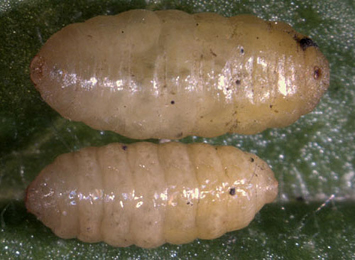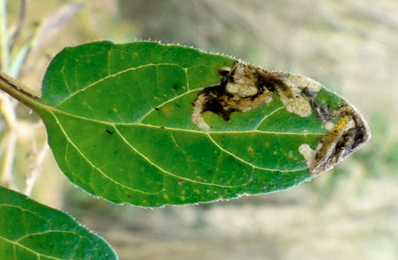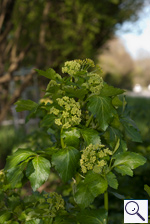|
||||||
|
SMYRNIUM. Alexanders. [Apiaceae] |
|
|
Two introduced species of Smyrnium are recorded in Britain, Alexanders (S. olusatrum) and Perfoliate Alexanders (S. perfoliatum). Three British miners are recorded on Smyrnium. A key to the European miners recorded on Smyrnium is provided in Bladmineerders van Europa. |
|
Key for the identification of the known mines of British |
1a > Leaf-miner: A large blotch, yellow or brown, preceded by a short corridor that in the end mostly is completely overrun. Generally several larvae share a mine. Especially in fresh mines the green primary and secondary feeding lines are well visible. Pupation outside the mine. Puparium yellow. |
 Euleia heraclei pupariria Image: © Willem Ellis (Bladmineerders van Europa) |
|
Euleia heraclei (Linnaeus, 1758) [Diptera: Tephritidae]. |
1b > Leaf-miner: Mine linear throughout, running first for a very short length on the lower surface, then remaining on the upper surface. A narrow early section is deeper than the rest; frass in black grains or lumps in two irregular rows, later one. Pupation external, exit slit through lower surface (Spencer, 1972b: 108). |
|
Phytomyza smyrnii Spencer, 1954 [Diptera: Agromyzidae]. |
1c > Leaf-miner: Rather narrow corridor, untidy and sometimes branched, starting from the base of the leaf, in particular the midrib. Sides of the corridor irregularly eaten out, not really parallel. Frass mostly present, and then in a central line. The larva is capable of leaving the mine and start a new one elsewhere. These later mines are much broader, and the frass is scattered irregularly.. |
 Mine of Orthochaetes insignis on Prunella vulgaris Image: © Jean-Yves Baugnée (Bladmineerders van Europa) |
|
Orthochaetes insignis (Aube, 1863) [Coleoptera: Curculionidae]. |
| Last updated 07-Jul-2019 Brian Pitkin | ||

